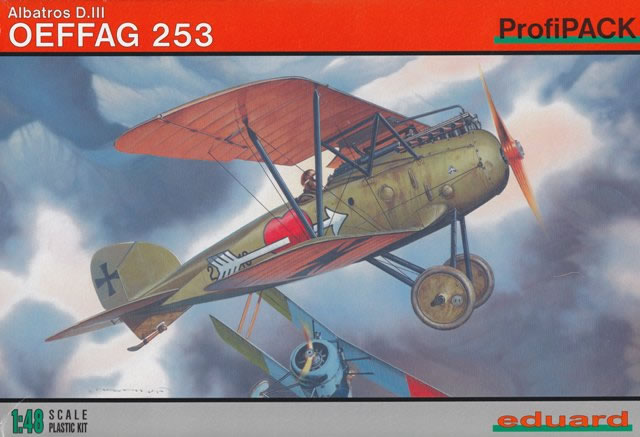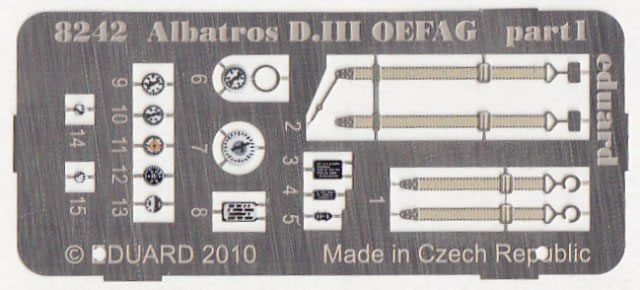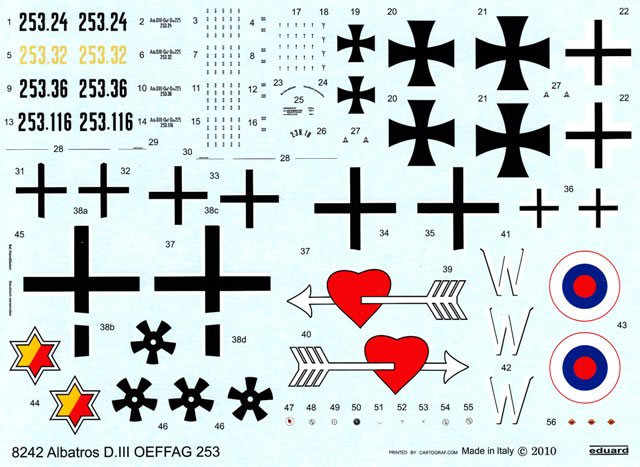Albatros D.III OEFFAG 253 ProfiPACK

Eduard, 1/48 scale
S
u m m a r y |
| Catalogue Number: |
Eduard Kit No. 8242 - Albatros D.III OEFFAG 253 ProfiPACK |
| Scale: |
1/48 |
| Contents and Media: |
Olive coloured plastic parts; photo-etched parts; markings for one aircraft. |
| Price: |
USD$34.95 plus shipping available online from Eduard's website
and specialist hobby retailers worldwide |
| Review Type: |
FirstLook |
| Advantages: |
Well moulded parts with no sink marks or ejection pins marring the finished product; sharply defined detail; frets of both coloured and standard photo-etched parts; excellent overall accuracy; handy express masks; varied collection of colour schemes for decals with perfect registration and minimal carrier film. |
| Disadvantages: |
|
| Recommendation: |
Clearly Eduard’s new process of kit manufacture has worked. It has allowed a higher level of detail to be incorporated into their WWI subjects and does so without compromising the fit. Previous main stream manufacturers have neglected these Oeffag fighters but thankfully these colourful and successful aircraft are now given their due respect. |
Reviewed by
Rob Baumgartner

Eduard's 1/48 scale Albatros D.III OEFFAG 253 is available online from Squadron.com
The most popular fighters flown by the Austro-Hungarian Luftfahrtruppe were the various forms of Albatros D.III built by the Oesterreichische Flugzeugfabrik AG.
They came at a time when the treacherous Brandenburg D.I “star strutter” had to face the ever increasing might of the Italians. Fortunately the Oeffag was farsighted enough to make their licence built machines sturdier than their German counterparts. Not only were the wings made stronger but its airframe was bolstered as well. This meant that the aircraft could be powered by engines of increasing horsepower.
When the first D.III (Oef) fighters reached the Front in June 1917, they were met with an enthusiastic response. They had a far better rate of climb than the Brandenburg D.I and also possessed superior manoeuvrability.
Initial types were powered by the Daimler 185 hp engine and eventually culminated in the improved 225 hp version in May 1918. It’s this latter type that Eduard has decided to release as their first foray into the Albatros D.III (Oef) series.
Contents
Various forms of the famous Albatros fighter have been produced by Eduard.
These focused on subjects flown in the German Air Service. For a while now, there were rumours of an “Austro-Hungarian” version being developed by this manufacturer. Just when enthusiasts were beginning to give up hope...it was announced.
Inside the box it is immediately apparent that the level of detail and moulding has been stepped up a notch. The evidence is seen on each of the 5 tan coloured sprues which make up a total of 88 plastic parts.
Being a “ProfiPACK”, the modeller is also blessed with two frets of photo-etched parts (one coloured), a set of painting masks, and a decal sheet allowing for 5 interesting options.
Construction starts with the engine and this is the same competent design we first saw in the Fokker D.VII (MAG). This superb power-plant is made up of 14 plastic parts, with further detailing coming courtesy of another 6 etched metal items.

The rest of the kit is all new with nothing coming from any of the previous Albatros releases.
Over 35 parts are needed to complete the cockpit which is dramatically different in layout to its German counterpart. Some moulded structural detail can be found on each of the inner fuselage halves and to this is added a wealth of other fittings.
The modeller has a choice of instrument faces which can be in either decal or coloured p-e formats. The latter also contributes to the seat belts and various placards around the airframe. A dry run showed that there were no problems at all with assembly and that this should be one the easier WWI kits to build.
A good example of the aforementioned detail can be seen on the wings. Here we see a subtle representation of the stitching which can be found on each of the well defined flying surfaces. Also present are the ply formers along the leading edge and the strips around the trailing periphery. These areas really show the high level of research that has gone into this kit. The latter is perhaps a bit too exaggerated and this can also be said about the height of the rib locations. Nonetheless, these features will be less noticeable under a coat or two of paint.
Rudder, elevator and ailerons are all separate parts with the latter having moulded on actuators. This makes animating your subject a breeze. Kudos should also be directed at Eduard for including the characteristic “washout” to the ailerons. The radiator will pose no problems either as this has been skilfully incorporated into the upper wing. As with all of the parts in this kit, there were no sink or ejection pin marks that would compromise the finished product.
A number of different options are catered for and this results in many alternate parts. Two upper decks are provided so that versions with both buried and exposed guns can be built. Looking at other unused portions of the kit, it’s easy to see how the earlier series 53 and 153 aircraft can be built.
The fuselage detailing is quite exquisite and clearly shows the method of attaching the ply sheets. These were butt jointed as opposed to the scarf joints used by Albatros. One anomaly that’s simple to fix is the extra hatch that Eduard have mistakenly added under the starboard cockpit opening. This doesn’t appear on period photographs but is easy enough to sand off.
All of the smaller items carry the same sharp, crisp detail that is found elsewhere in the kit. Struts, undercarriage legs, and wheels are all in scale, with choices of airscrews and short or long barrelled Schwarzlose machine guns.
The frets of photo-etched parts add a touch of finesse to the finished product. Aside from the cockpit and engine enhancements, there are pieces for a flare rack, thrust plate, anomometer, gun sights and tyre access covers. They also cater for the control horns and even incorporate the turnbuckles. This all assumes that the control surfaces are in the neutral position so the assembly will have to be modified if you plan to offset these items.

The instruction booklet clearly shows how everything fits together and includes the all important rigging guide. A handy masking set is also included which makes painting the wheels a lot easier.
Marking Options
There are 4 different aircraft that that are presented in this offering with one machine being seen in an additional post-war scheme.

The single decal sheet is superbly printed with excellent definition and what looks to be good colour density. The carrier film is very thin and is kept to a minimum around the edge of the design. Stencil data, logos and the aforementioned instrument faces complete the very comprehensive package.
Albatros D.III (Oef) 253.24, Flik 51/J, Ghirano, September 1918
Benno Fiala was one of a number of pilots that flew this aircraft but did not score any of his 28 victories in it. He was the third most successful LFT ace and survived the conflict to lead an interesting post-war life. This included a stint as Hugo Junker’s personal assistant as well as being commander of an airbase in the Luftwaffe during WWII. He died in 1964 aged 74 years old.
Albatros D.III (Oef) 253.32, Flik 63/J
This aircraft can be seen in conjunction with a series 153 Albatros when wrecked at Portobuffole airfield in 1918. Both came to grief as a result of a “whirlwind” on 23rd September.
Albatros D.III (Oef) 253.36, Flik 56/J, August 1918
As the fuselage marking suggests, this machine was the mount of Oblt. Othmar Wolfan. He gained his single victory in this aircraft after downing a Sopwith Camel on 1st August 1918. Just over a month later he was hospitalised from a crash which forced him to sit out the rest of the war.
Albatros D.III (Oef) 253.116, Oblt. Friedrich Navratil, Flik 3/J, Fall 1918
This aircraft is a perennial favourite amongst LFT fans and was one of Navratil’s favourites. He was an outstanding leader and always led by personal example. The 10 victory ace severely injured himself when the seat of his aircraft broke and he was forced to make an emergency landing. The plane (obviously not this one) was destroyed and the war ended before his recuperation was complete.
Albatros D.III (Oef) 253.116 Sgt., Adolf Bláha, November 1919
After the war, Adolf Bláha flew Navratil’s fighter to Switzerland where it was subsequently interned. Almost a year later, after much negotiating, it was acquired by Czechoslovakia and Bláha flew it to Prague. Sadly the aircraft suffered engine failure and the machine was written off after a forced landing.
Austro-Hungarian fighters are usually neglected by kit manufacturers. Hopefully this turns the tide.
The quality of the mouldings is better than anything Eduard has done before and a trial fit of major components is extremely encouraging. The extra parts in the kit clearly indicate the earlier versions that will be released and the astute modeller can make use of these items now.
Overall this manufacturer has produced an exceptional example of this subject and the good news is that more are on their way.
Thanks to Eduard for the sample
Review Text and Images Copyright © 2010 by Rob Baumgartner
Page Created 12 September, 2010
Last updated
12 September, 2010
Back to HyperScale Main Page
Back to Reviews Page

|
